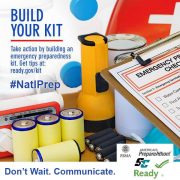Build a Kit
Basic Disaster Supplies Kit
A basic emergency supply kit could include the following recommended items:
- Water, one gallon of water per person per day for at least three days, for drinking and sanitation
- Food, at least a three-day supply of non-perishable food
- Battery-powered or hand-crank radio and a NOAA Weather Radio with tone alert and extra batteries for both
- Flashlight and extra batteries
- First aid kit
- Whistle to signal for help
- Dust mask to help filter contaminated air and plastic sheeting and duct tape to shelter-in-place
- Moist towelettes, garbage bags and plastic ties for personal sanitation
- Wrench or pliers to turn off utilities
- Manual can opener for food
- Local maps
- Cell phone with chargers, inverter or solar charger
Once you have gathered the supplies for a basic emergency kit, you may want to consider adding the following items:
- Prescription medications and glasses
- Infant formula and diapers
- Pet food and extra water for your pet
- Cash or traveler’s checks and change
- Important family documents such as copies of insurance policies, identification, and bank account records in a waterproof, portable container.
- Emergency reference material such as a first aid book or free information from this website.
- Sleeping bag or warm blanket for each person. Consider additional bedding if you live in a cold-weather climate.
- Complete change of clothing including a long-sleeved shirt, long pants and sturdy shoes. Consider additional clothing if you live in a cold-weather climate.
- Household chlorine bleach and medicine dropper – When diluted, nine parts water to one part bleach, bleach can be used as a disinfectant. Or in an emergency, you can use it to treat water by using 16 drops of regular household liquid bleach per gallon of water. Do not use scented, color safe or bleaches with added cleaners.
- Fire extinguisher
- Matches in a waterproof container
- Feminine supplies and personal hygiene items
- Mess kits, paper cups, plates, paper towels and plastic utensils
- Paper and pencil
- Books, games, puzzles or other activities for children
Remember the unique needs of your family members, including growing children, when making your emergency supply kit and family emergency plan.
For Baby:
- Formula
- Diapers
- Bottles
- Powdered milk
- Medications
- Moist towelettes
- Diaper rash ointment
For Adults:
- Denture needs
- Contact lenses and supplies
- Extra eye glasses
Ask your doctor about storing prescription medications such as heart and high blood pressure medication, insulin and other prescription drugs.
If you live in a cold climate, you must think about warmth. It is possible that you will not have heat. Think about your clothing and bedding supplies. Be sure to include one complete change of clothing and shoes per person, including:
- Jacket or coat
- Long pants
- Long sleeve shirt
To download a PDF version click HERE
*This list is compiled byFEMA and Ready.gov
![SASSER CO 1L[1] Sasser Companies, Inc](https://sassercompanies.com/wp-content/uploads/2015/08/SASSER-CO-1L1.jpg)


